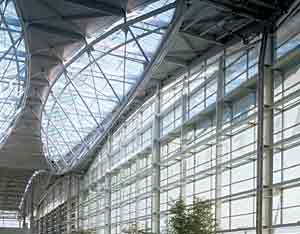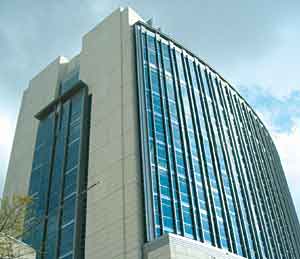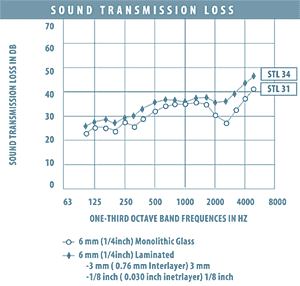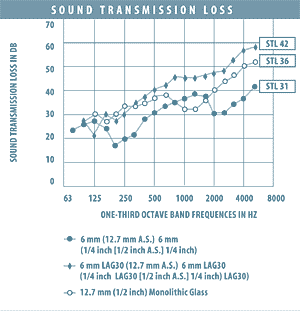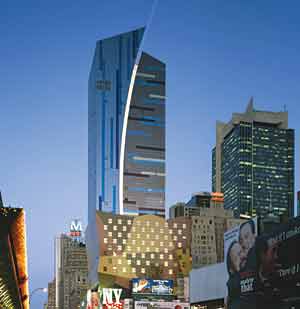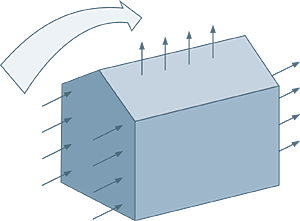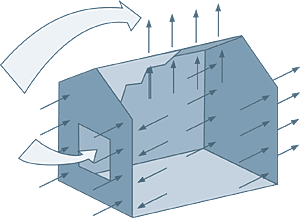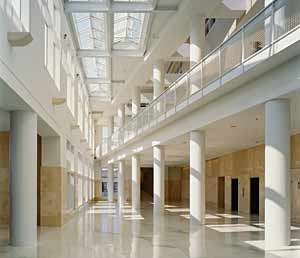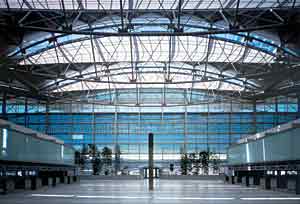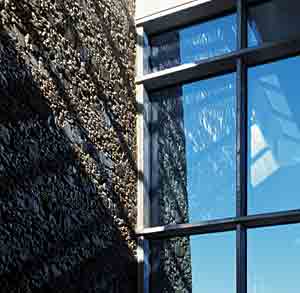Exploring the High-Performance Benefits of Laminated Glass
Versatile Building Material Provides Multiple Advantages
![]() Continuing Education
Continuing Education
Use the following learning objectives to focus your study while reading this month’s Continuing Education article.
Learning Objectives - After reading this article, you will be able to:
- Understand how laminated glass addresses design and safety challenges.
- Recognize the benefits of laminated glass during hurricanes and earthquakes.
- Explain why laminated glass offers a high degree of security protection.
- Discuss how laminated glass reduces sound transmission.
- Identify the sustainable, energy-efficient performance qualities of laminated glass.
Global terrorism and natural disasters have emphasized the need for architects to address emerging design challenges regarding safety, security, sustainability, and energy efficiency. As the building industry examines these performance issues and design criteria, architects are increasingly turning to laminated glass because of its many high performance benefits.
While laminated glass is a relatively new architectural product in the United States, it has been a popular design tool in Europe for many years. Europe's experience with blasts and natural disasters has led many countries to place a premium on the safety and security of their citizens, especially in public buildings. Standards vary by country, but generally all government and public buildings including hospitals, daycare centers, airports, post offices, and train stations, must be built to withstand blast. In addition to the safety, security, and sound reduction benefits it affords, laminated glass also contributes to sustainability goals, which has further driven demand in many European countries.
|
Laminated glass is formed by permanently fusing an interlayer between two pieces of glass under heat and pressure. It is rapidly becoming a popular alternative to the often-specified tempered glass in safety and security applications. Unlike tempered safety glass, which breaks into small pieces instead of sharp shards, laminated glass remains in the frame, maintaining the building envelope and protecting building contents. Laminated glass also offers multiple security, sound, safety, daylight, and energy benefits, unlike tempered glass.
Safety
Safety glazing refers to the reduction of the risk or occurrence of injury or loss from accidental or natural causes, while security glazing refers to the reduction of the risk or occurrence of injury or loss from the deliberate or intentional human actions. Safety glazing is specified to protect people from injuries due to accidental glass impact, breakage or fallout, and laminated glass is rapidly emerging as a powerful and versatile safety glazing option. Upon impact, ordinary glass typically shatters and falls from the window frame, which can result in serious or even fatal injuries to building occupants and passers-by. Used in a properly designed system, laminated glass windows may crack, but fragments tend to adhere to the interlayer, reducing hazards associated with falling or flying glass.
|
||||||||||||||||||||||
Laminated glass is versatile and suitable for almost any desired configuration. By using laminated glass as the inboard component of an insulating unit, the assembly provides the thermal performance of an insulating air space along with the safety glazing of the inboard laminate.
In appropriate configurations, laminated glass meets all requirements set forth in architectural glazing safety sections of major model building codes and test standards such as the Consumer Product Safety Commission (CPSC). Category I certification requires the glazing to withstand one 150 foot-pound impact, produced by impacting a 100-pound shot bag from a vertical height of 18 inches. Category II certification requires the glazing to withstand one 400 foot-pound impact, produced by impacting a 100-pound shot bag from a vertical height of 48 inches.
Laminated glass has also been shown to meet Underwriters' Laboratories (UL) standard UL972 for security glazing, as well as Class I of the American Society of Testing and Materials (ASTM) International's F1233 security glazing test standard.
In vertical safety glazing applications, laminated glass has proven to be a unique design tool for entrance doors, shower and bath enclosures, storm and patio sliding doors, sidelights, and fixed glazed panels. The glass also meets significant design and safety challenges presented by sloped and overhead glazing surfaces.
Security
Around the world, architects and building owners are seeking to balance the desire for living and working in bright, daylit spaces with the need for security protection against criminal and terrorist attacks.
|
Burglary and Forced Entry Resistance
Burglaries in commercial buildings and residences are usually directed towards targets of easy opportunity and low perceived risk. The most critical step of a burglary is entry, and the most common means of entry is a window or door.
In correct configurations, laminated glass meets the requirements of significant test standards including: UL972 of laminated glazing products against forced entry, ASTM International and other test standards for security in Home, Commercial and High Security categories. While many forms of laminated glass are considered strong enough to prevent "smash and grab" burglaries, systems can be designed with appropriate glazing thicknesses to resist most weapons used to force entry, including: rocks, hammers, screwdrivers, bricks, pry bars, sledgehammers, pipes, battering rams, chisels, axes, thermal stress weapons (CO2, fire extinguishers or propane torches), and chemical deterioration weapons (gasoline and acetone). Even quiet glass cutters become useless tools because laminated glass cannot be cut from only one side. Security glazing products with the greatest overall thickness and largest percentage of interlayers offer the best resistance to forced entry.
|
Because it withstands most forms of attempted entry, laminated glass is frequently used for enhanced security in residential and commercial windows, doors, and storefronts, providing an aesthetically superior alternative to iron bars. Unlike burglar alarms and other security systems, security glazing provides continuous passive security that is not subject to human error or electronic failure. It ultimately provides greater protection by preventing entry instead of reacting to an entry.
Ballistic Protection
In addition to withstanding the blows of a variety of objects during an attempted burglary, laminated glass offers protection against ballistic (bullet) attack. In specific ballistic configurations, laminated glass can reduce the risk of injuries from a ballistic attack without compromising the complete visual clarity afforded by a glass system. It can also resist penetration by high-velocity ballistics when constructed in multiple alternating layers of glass and interlayers.
|
|||||||||||||||||||||||||||||||||||||||||
UL test 752 tests the ability of glazing to withstand penetration by various classes or levels of firearms. In order to pass certification for a certain level, the projectile (bullet) must not penetrate the glazing and must not result in large fragments of glass being forcibly thrown from the witness side of the sample for a distance of 18 inches or more. Based on the UL tests, certain laminate thicknesses are needed to resist specific ballistic impact. Thicker security glazing will exhibit greater resistance to both penetration and glass spall (tiny slivers of glass).
Because of its demonstrated ability to withstand ballistic penetration, laminated glass is often used to provide round-the-clock protection to employees in high-risk facilities such as banks and prison control rooms, which require extreme ballistic protection and complete visual clarity.
Blast Resistance
Several of the survivors of the September 11, 2001 Pentagon attack credit blast-resistant laminated glass with saving their lives. The impacted section of the building had just been renovated for security upgrades, which included windows manufactured with a laminated glass component. After the explosion, these windows remained in the frames, providing building occupants protection from flying glass shards.
|
Experts at Texas Tech Glass Research and Testing Laboratory estimate that approximately 75 percent of all damage and injury from bomb blasts can be attributed to flying and falling glass following an explosion. They note that a single square foot of unprotected glass can project as many as 100 sharp shards of glass flying at speeds of up to 300 feet per second. Laminated glass provides passive protection and can mitigate the effects of a blast in several ways. Most importantly, it protects people, both within the targeted building and in the surrounding area and structures. Because laminated glass stays within its frame during the initial blast wave and when impacted by flying debris, it reduces or eliminates flying glass to prevent injuries, and provides protection against flying debris. The glass also protects the building, reducing collateral damage, opportunity for looting, and costs to repair the targeted and surrounding buildings. The performance of laminated glass is often compared to ordinary monolithic glass based on retentivity, or ability to stay in the opening or hold on to glass fragments.
Because of these characteristics, laminated glass meets stringent blast-resistant standards outlined by the U.S. Department of State and the U.S. General Services Administration (GSA), and is used in many federal buildings.
Sound
Anyone who has ridden in a luxury automobile has likely noticed the dramatic difference in perceived interior noise between luxury and economy cars. Today, the same technology used to dampen noise in cars is being used in building architecture. In many building types ranging from concert halls and office buildings to homes and schools, isolating interior spaces from exterior noise is critical, and laminated glass effectively reduces sound transmission between indoor and outdoor spaces.
Sound transmission through glass or any other building material is related to the limp/mass law. The heavier and more flexible the building material is, the better it will be at reducing sound transmissions. Because ordinary monolithic glass is essentially lightweight and very stiff, it tends to transmit more sound than other building materials.
|
Adding laminated glass to a glazing system is one of the best ways to optimize performance. The PVB interlayer effectively absorbs significantly higher levels of soundwaves than monolithic glass, thus creating a greater sound barrier. Adding a pane of laminated glass to an insulating glazing system gives the unit an even higher Sound Transmission Class (STC), blocking more soundwaves.
The key to creating an acoustically insulated indoor environment is to select products with a high STC, which is used by acoustical engineers as a measure of a building materials' resistance to the passage of sound. The higher the STC, the better the sound barrier.
|
Acoustic performance is especially critical in airports and surrounding structures, hotels, restaurants, and schools. At the San Francisco Airport International Terminal, designed by Skidmore, Owings and Merrill, LLP, laminated glass dampens noise of runway activity and overhead air traffic and provides seismic protection. On the other coast, the Westin New York hotel in Times Square, designed by Arquitectonica, uses insulating laminated glass with high-performance coatings to minimize outside noise from busy midtown Manhattan. The innovative design features a colored glass panel exterior that blocks sound and provides guests with a quiet indoor oasis in New York City.
Use of laminated glass for noise reduction provides building occupants with the highest level of environmental comfort. The glass blocks noise and lets in natural light. In addition to walls and windows, laminated glass can also be used in interior applications such as floors, shower and bath enclosures, partitions and room dividers, elevators, and doors.
In these applications, laminated glass helps eliminates the "cocktail effect" in interior spaces, in which multiple voices, noise sources, and reverberations occur in an occupied space. A room with high noise absorption will yield an environment that is conducive to improved hearing and higher productivity.
Sustainability
The sustainability movement has become one of the world's leading architectural trends. In the U.S., buildings account for 39 percent of total energy use and 68 percent of total electricity use. Sustainable design supports efforts to conserve and restore natural resources and reduce waste. The resulting benefits include enhanced occupant comfort and health, energy efficiency, and improved quality of life.
|
Laminated glass usage contributes to sustainability goals by maximizing natural light in a building while minimizing heat gain. The laminate interlayer provides a number of options when specifying laminated glass for daylighting. Various laminates, including colored or textured interlayers, can let in appropriate amounts of light and diffuse the light throughout interior spaces. Tinted glass substrates, coatings, and silkscreen patterns may also be used. Ultimately, daylighting may reduce cooling costs, as natural light produces less heat than artificial light. Various studies, including one by the Rocky Mountain Institute, have noted that this may also improve occupant productivity and health, and create a more pleasant environment.
Daylighting with laminated glass can also reduce energy costs associated with lighting and cooling a building. A standard light bulb produces 85 percent heat and 15 percent light. In the U.S., 40 to 50 percent of total energy consumed by buildings is for electric light and to remove the heat it produces. Reducing the amount of artificial light reduces both electricity costs and cooling costs associated with removing the heat from the electric lights.
|
||||
|
LEED Categories
The U.S. Green Building Council's Leadership in Energy and Environmental Design (LEED) Green Building Rating System® was formed to create a consistent green building rating system and a uniform sustainability building standard. Its goal is to raise awareness and use of green building methods, by outlining ways to achieve green building points and ratings. Laminated glass contributes to several LEED categories, including Energy and Atmospheric, Materials and Resources, and Indoor Environmental Quality.
|
||||||||||||||||||||
|
||||||||||||
|
|||||||||||||||||||||||||||||||||||||||||||||||||||||||
Natural Disaster Protection
Laminated glass provides excellent protection against hurricanes and seismic conditions.
Hurricane Protection
The massive destruction of property and buildings from hurricanes has tragically emphasized the importance of hurricane-resistant building methods and codes. Experience has shown that structures built to certain minimum wind-borne debris and impact standards can successfully withstand a strong hurricane, while structures not built to certain minimum requirements are often severely damaged. Combined with other structural safety measures, the use of laminated glazing can be critical to a building remaining intact after a hurricane. There were numerous examples of hurricane-resistant windows performing well following Hurricanes Charley of 2004, and Katrina, Rita and Wilma of 2005.
|
Glass windows and doors tend to be some of the weakest points of a building. Left unprotected, they can be shattered by hurricane-force winds and flying debris. If the building envelope is breached, wind enters the building, causing a dramatic increase in internal pressure. Internal pressure, coupled with the external pressure on the structure, can effectively double forces to lift the roof and exert pressure on the outside walls, causing structural failure. Thus, if glazed openings are penetrated, severe structural damage or complete structural destruction often occurs.
Even if severe structural damage is avoided, broken windows and doors allow wind and water to enter a building, which can completely destroy a building's contents. In the case of a residential structure, even if a house is left standing, everything that makes that house a home may be destroyed, and mold becomes a serious issue.
|
The Dan M. Russell Jr. United States Federal Courthouse in Gulfport, Mississippi, designed by R.M.Kliment + Frances Halsband Architects, weathered Hurricane Katrina in August 2005. Situated between Biloxi and New Orleans, Gulfport faced extreme winds and hurricane conditions when Katrina struck. The eight-story federal courthouse, situated yards from the Gulf of Mexico, features a concrete exterior punctuated by large expanses of glass, which allows occupants to enjoy natural light and ocean views. In order to provide protection against hurricanes and address security and energy-efficient design criteria, insulating laminated glazing with a low-e coating was used throughout the project, in windows, curtain walls, and overhead glazing. Thanks to this careful planning and construction and laminated glass protection, the courthouse survived the storm intact.
As a result of the many hurricanes and ensuing property damage that has impacted Florida, the state has aggressively pursued rigorous hurricane-related building standards, and has building codes that are among the most stringent in the world. However, glazing standards outside Florida are not as stringent, and even nonexistent, in many coastal areas, which may have contributed to the devastation in Louisiana, Mississippi, and Alabama during the 2005 hurricane season. In fact, a Louisiana State University (LSU) Hurricane Center study presented by Center Director Dr. Marc Levitan estimated that the implementation of mitigation measures including opening protection, improved roof sheathing attachment, hurricane straps and clips, and secondary moisture protection could have reduced estimated residential wind losses during Hurricane Katrina by more than 75 percent.
In recent years, laminated glass has emerged as one of the best measures of glazed opening protection against hurricanes. Because of the tough interlayer, laminated glass may crack if impacted by debris and hurricane-force winds, but the fragments adhere to the interlayer, preserving the building envelope and eliminating flying glass. Commercial and residential window and door systems must meet various impact, windborne debris, and cyclic wind pressure tests in order to satisfy hurricane-related building codes. The test procedures call for the entire assenbly of the glass and glazing system to meet protocol. Depending on the distance above grade, the assembly is either subjected to the large missile or small missile impact test, followed by pressure cycling.
A system may also need to pass additional tests such as air and water infiltration, structural load and forced-entry resistance to comply with some building code requirements.
|
|||||||||||||||||||||||||||||||
Properly designed window and door systems manufactured with laminated glass have proven successful in meeting major building codes and test standards such as the Florida Building Code, including the High Velocity Wind Zone (Dade County); International Building Code; ASTM and Texas Department of Insurance. While certain other protection methods such as storm shutters also meet many standards, laminated glass offers continuous passive protection to a building's structure, contents, and inhabitants without the need for storing and properly installing unwieldy shutters or storm screens.
|
Seismic Protection
The performance of architectural glazing under seismic conditions is highly dependent upon the design and structural components of the glazing system. When designing buildings in geographical areas prone to seismic activity, laminated glass offers two major forms of protection. Most importantly, it protects people from dangers due to falling glass. Ordinary glass used in windows and storefronts does not perform well under severe racking conditions. The glass tends to fall out of the frame and shatter onto the street or sidewalk. Laminated glass, however, remains in its frame when broken, reducing or eliminating falling glass. Laminated glass can also help maintain building envelope integrity by helping to keep the building secure and weather-tight until repairs are completed.
The behavior of laminated and annealed glass can be analyzed when subjected to two dynamic cyclic spectra.
|
|||||||||||||||||||||||||||||||||||
Glass specimens were subject to racking in the plane of the wall and to racking that moved the bottom supports both along their axis in the plane of the wall, as well as out of the plane of the wall but parallel to the top supports. The latter action simulates interstory drifts between floors in both horizontal directions. The impressive performance of laminated glass shows that laminated glazing can be specified to protect occupants and pedestrians from falling glass during a severe earthquake and continue to protect the building envelope.
|
Security and Blast Resistance
The dangers associated with flying glass during an explosion became tragically evident in the aftermath of the 1995 Alfred P. Murrah bombing in Oklahoma City. More than 200 people were injured by shards of glass in a two-mile radius of the bombing. A staggering 80 percent of the windows within two blocks were affected; within one-and-a-half blocks, 100 percent. The General Services Administration's (GSA) new Oklahoma City Federal Campus, designed by Ross Barney + Jankowski, employs laminated glass to create a bright, daylit building that reflects the GSA's goal of transparent security, providing a high level of protection invisible to the public eye.
It is, however, important to note that while laminated glass is a critical element when designing blast-resistant structures, the glass must be set in an adequately designed frame in order to be effective.
While laminated glass was initially used by GSA to respond to the threat of terrorism against the new Oklahoma City Federal Campus, it has since become a design standard for federal buildings across the country. GSA requires that all federal courthouses and other high-security buildings be built with blast-resistant glazing, and laminated glass is one of the only glass solutions strong enough to meet these requirements. Just as in the Oklahoma City campus, laminated glass is also being used in other public- and private-sector buildings to create secure environments that appear open and accessible to the public, thereby balancing security and openness.
Multiple Benefits for many Applications
It is important to remember that laminated glass must be used in an appropriate configuration to provide the desired level of protection and performance. Available in a variety of glass and laminate thicknesses and in a number of insulating and non-insulating configurations, laminated glass is suitable for many applications. In addition to selecting the appropriate glass configuration, it is important to select a suitable framing system. For hurricane or blast protection conditions, the framing system must be strong enough to support the glazing.
|
Today, laminated glass is proving to be a significant design element in meeting twenty-first century architectural challenges. A versatile material, it provides building projects with multiple benefits, from safety and security protection and resistance to natural disasters, to sound transmission, sustainability, and many design options. The ability to coordinate with an insulating unit and high performance coatings gives laminated glass even greater performance qualities. With a nearly infinite selection of colors, textures, and laminate combinations available, laminated glass offers architects many opportunities to create outstanding buildings and achieve design excellence.

